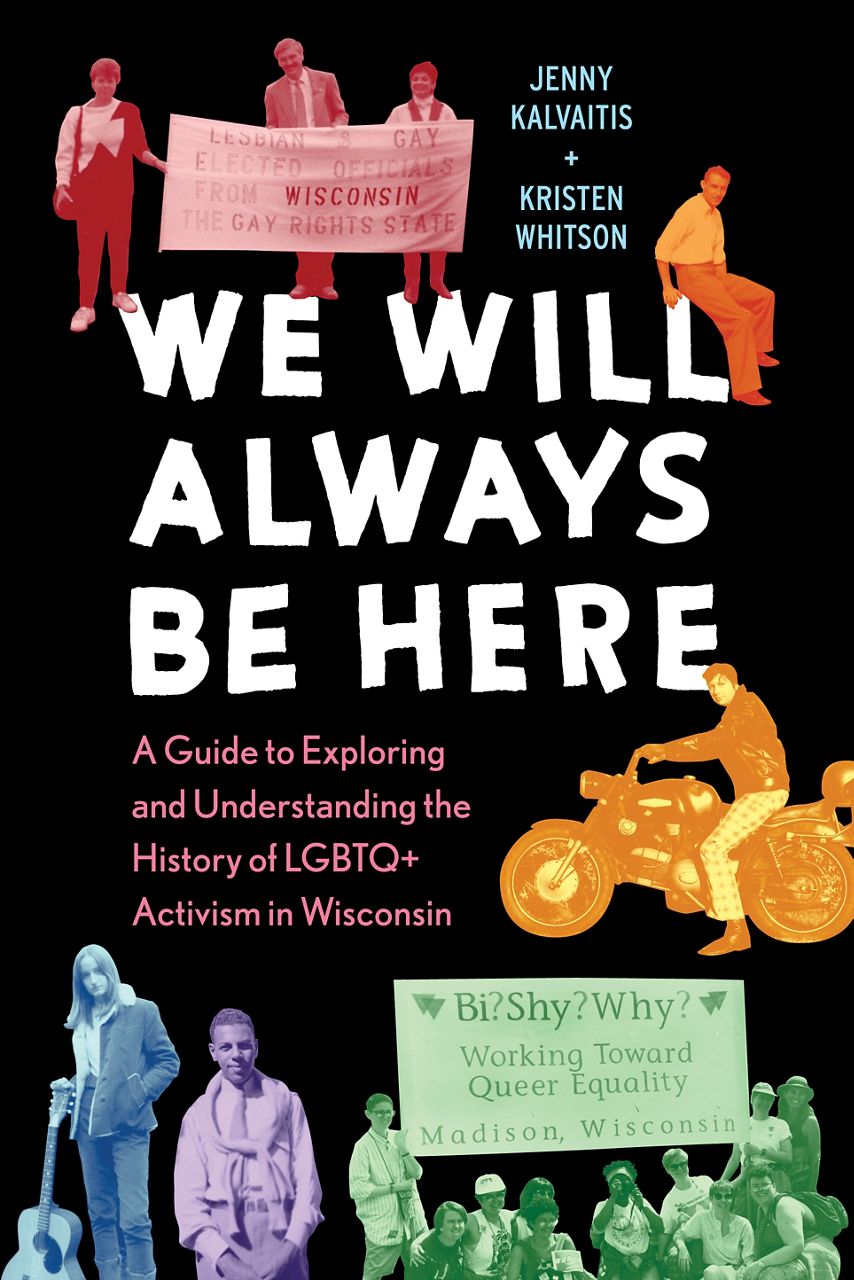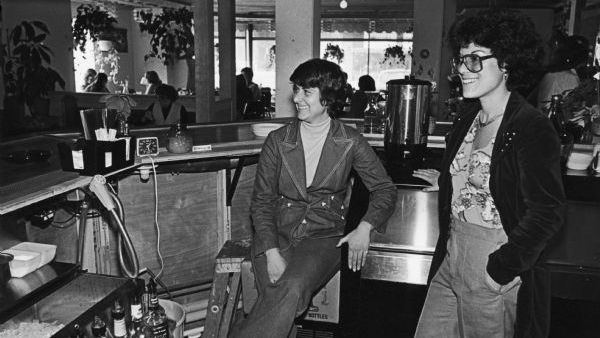MADISON, Wis. — When historian and educator Jenny Kalvaitis was growing up, people didn’t talk much about LGBTQ+ rights.
“For the vast majority of the population, there wasn’t a conversation,” Kalvaitis said.
Today, she said young people are more aware of LGBTQ+ issues and events. But when it comes to the rich history of activism in Wisconsin, lots of gaps persist.
“If they know any LGBTQ history, it’s Stonewall. It’s the Lavender Menace,” Kalvaitis said. “It’s these international and national LGBTQ history movements. But they don't know that, for example, Wisconsin was called the ‘Gay Rights State’ and was the first state to pass the nondiscrimination law.”

Kalvaitis, who has an education background, teamed up with archivist Kristen Whitson to produce a new resource for young people in the Badger State, published this month by the Wisconsin Historical Society Press.
Their book, “We Will Always Be Here,” dives into the history of LGBTQ+ activism in Wisconsin, focusing on primary sources from across the state.
The authors said they wanted to include a wide range of experiences, drawing people from different backgrounds and parts of the state. Their book includes everyone from early LGBTQ+ individuals who were attacked for expressing themselves, to the many activists and groups who decided to speak out in the growing movement for gay rights.
When the authors themselves were growing up, they said they didn’t see a lot of conversation about LGBTQ+ people or their history. Now, they hope their work can help a new generation of teens see themselves as a part of history.
As the authors write in the book’s introduction: “It is time to look back and begin learning these stories. It is time to take them off the shelf and out of the closet. It is time to put them in the hands of people like you, who can use the past to build a better future.”
Going way, way back
The discussions we see today around LGBTQ+ people and identities are all part of “a conversation that began centuries ago,” Kalvaitis said. As the authors write, LGBTQ+ is a modern acronym — but the identities it describes are not new.

Still, it can be hard to find these stories if you don’t know where to look, the authors said. Luckily, with her background working in LGBTQ+ archives, Whitson had some ideas — even though the pandemic made it a little trickier to track down documents, many of which aren’t digitized.
One early figure highlighted in the book is Ralph Kerwineo, who lived in Milwaukee at the turn of the 20th century and became the center of a 1914 court case.
Kerwineo was living and working as a transgender man, in a society that didn’t accept his idenitity, Kalvaitis explained. After being arrested for cross-dressing, which was illegal at the time, he was ordered by a judge to live out the rest of his days as a woman.
“My heart and soul are more those of a man than a woman,” Kerwineo remarked after the ruling.
Other LGBTQ+ Wisconsinites in history found creative ways to be true to themselves in a society that didn’t accept them: The gay author (and “prolific partier”) Glenway Wescott wrote fictional versions of his life into his short stories, Kalvaitis said — like one in which a male character dresses up as a woman so he can go to a Halloween party as another man’s date. And the book details the “magic group” run by Ted Pierce in the 1950s, which became a way for gay men to gather in a safe community.
Sometimes, early LGBTQ+ Wisconsinites weren’t necessarily able to be out and proud, the authors said, but weren’t completely in hiding either. Bob Neal and Edgar Hellum, two men who lived as business and life partners in Mineral Point in the 1930s, were able to be part of the community and run a bustling restaurant.
It’s possible that, in cases like Bob and Edgar’s, people just didn’t have a lot of time or energy to spend on judging other people, Whitson said.
“I think for a very long time, there was a prevailing feeling in Wisconsin that you just sort of let people live the way they want to live,” she said.

“You’re not alone”
In more recent decades, the fight for LGBTQ+ rights started to come to the forefront — especially after the Stonewall riots in 1969, which were an important catalyst for activism across the country.
The book includes many documents from Wisconsinites who were vocal in the fight for LGBTQ+ rights — from Donna Burkett and Manonia Evans, two Milwaukee women who sued for the right to get married, to Judy Greenspan, an out lesbian who ran for the school board in Madison after a principal banned her from speaking to his school.
Lloyd Barbee, who’s well known for his role in fighting for civil rights and integration in Milwaukee, was also active in advocating for LGBTQ+ people, Kalvaitis added — arguing in a 1973 speech that “it’s time the government is taken out of the bedroom.”
With more LGBTQ+ visibility came more visible communities. Groups like the Gay Peoples Union in Milwaukee and Bi? Shy? Why? in Madison cropped up to provide support and solidarity. Lysistrata, a self-described feminist bar in Madison, effectively served as the city’s first known lesbian bar in the ‘70s and ‘80s, Whitson said.
Whitson said the story of Lysistrata was especially meaningful because she was able to meet with one of the bar’s original founders during the research process and see that the community around Lysistrata — whose physical building burned down in 1982 — still lives on.
“It’s not that you don't take it seriously when you're writing about people from 100 years ago or 200 years ago,” Whitson said. But writing about people who are still alive, and even people she knows, “just feels very personal,” she said.

In fact, many of the stories of LGBTQ+ activism are pretty modern in historical terms, the authors said. The Supreme Court’s decision on marriage equality was just a few years ago; the HIV/AIDS epidemic of the 1980s and ‘90s has had lasting societal impacts, even though many young people the authors surveyed said they didn’t learn much about it in school.
For Whitson, learning and writing about such recent history adds an extra emotional punch to the work.
“I’m a woman married to a woman, which means I am living a life that these people who lived not very long ago fought for,” Whitson said. “So that makes me feel a huge sense of responsibility to tell these stories well, to pass them on so that they're not a mystery to the next generation.”
And, of course, the fight for LGBTQ+ equality still isn’t over. As the authors point out in the book, even as attitudes toward gay rights have shifted quickly, legal protections for LGBTQ+ people are inconsistent, and many still face discrimination for their identities.
Kalvaitis said she hopes the book can provide some support for young people who might be struggling, and let them place themselves as part of a bigger story.
“Knowing our history has transformational power. It gives you roots to the place that you are,” Kalvaitis said. “To understand that you're not alone, or weird, or different in this world. That there have been people who belong to the LGBTQ community, who are like you, who have been in Wisconsin for as long as people have lived on the land.”
The authors will be holding a teen panel discussion on June 24 as part of a virtual book launch event, co-hosted by the Wisconsin Historical Society Press, Milwaukee Pride and Woodland Pattern Book Center. See here for more information.



